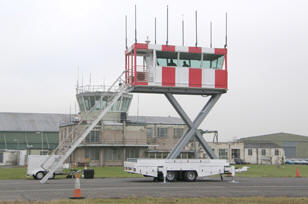 |
|
|
|
|
|
|||
|
By Mike Mitchell |
||||
 |
March 7, 2010 -
There has been a lot of publicity since the earthquake in
The Host Systems
team worked flat out to have a fully integrated
mobile ATC tower ready to go out to |
|||
|
Michael Brunton, Managing Director of Host Sytems commented: “The
“The Host Systems tower is transportable by Il-76 or C-130 and we could
have had our tower in
“I have been in disaster situations where ATC has been destroyed and
have seen for myself that the delay in receiving aid costs lives. It is
vital to the humanitarian effort to have effective ATC in place to
enable urgent deliveries by air and this is why we developed the
Each disaster highlights different logistical problems but in Port Au
Prince it is the ATC – being only a small airport it is not capable of
handling the large amount of aid planes especially on the ground, the
temporary unit does not elevate meaning the control of aircraft,
vehicles and people is made even more difficult, especially in a
confined area.
Michael went on to say: “We notified our government and aid agencies
that we have a tower still available for Haiti or for Chile and are
hoping that the authorities may consider using one of our towers in the
re-building program for Haiti.
We propose that our mobile tower is a safer long term option than
a conventionally built tower in an earthquake region.
|
||||
|
The system is very
stable and it can be lowered to the ground in 3 minutes via a simple
remote control unit, and stands on its own tiers and stabilizers.
The cabin structure is reinforced, and is fitted with blast proof
glass and would provide a safer working environment for air traffic
controllers than a built structure if further earth tremors hit the
area.”
Host Systems ATC
towers have been proven in very difficult working environments, and a
system is currently operating ATC at Michael Brunton added: “Our systems may not be as good looking as most ATC towers but they do exactly the same job, with a 20 year lifespan minimum can be considered a permanent solution.” |
| ©AvStop
Online Magazine
Contact
Us
Return To News
|
|
